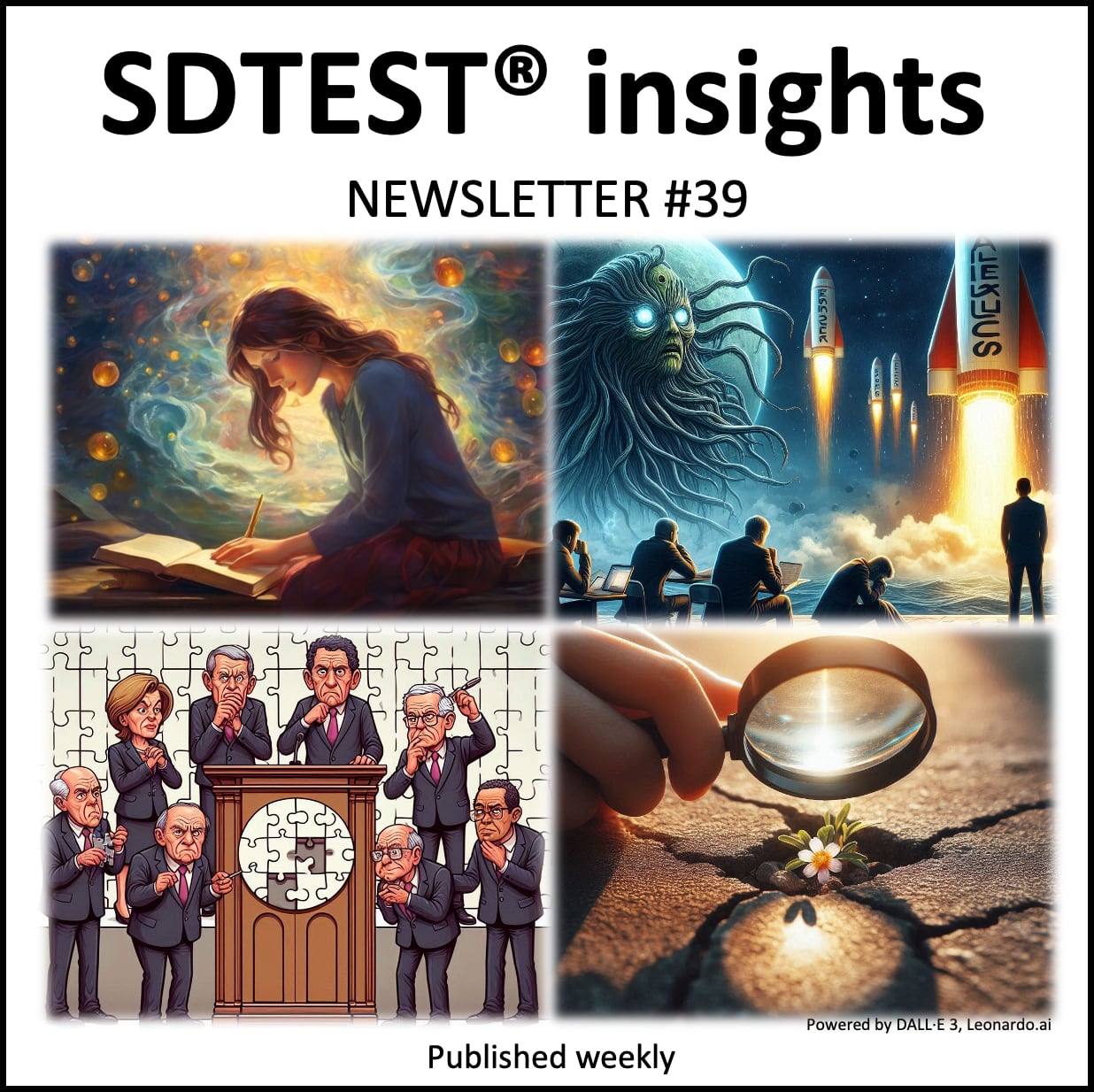SDTEST® has 36 different VUCA polls that calculate the 13,034 correlation values between stages of development according to the theory of Spiral Dynamics and answer options of these 36 polls.
We invite curiosity about the systemic mechanisms behind this correlation. There may be hidden variables that provide alternative explanations.
In our analysis of the poll "What makes people successful at work?" we found an intriguing positive correlation that warrants closer examination:
0.0419 between the Willingness to learn and the Purple stage.
The critical value of the correlation coefficient for a normal distribution, by William Sealy Gosset (Student) r = 0.0403. This positive correlation of 0.0419 meets the reliability criteria but does not necessarily imply causation.
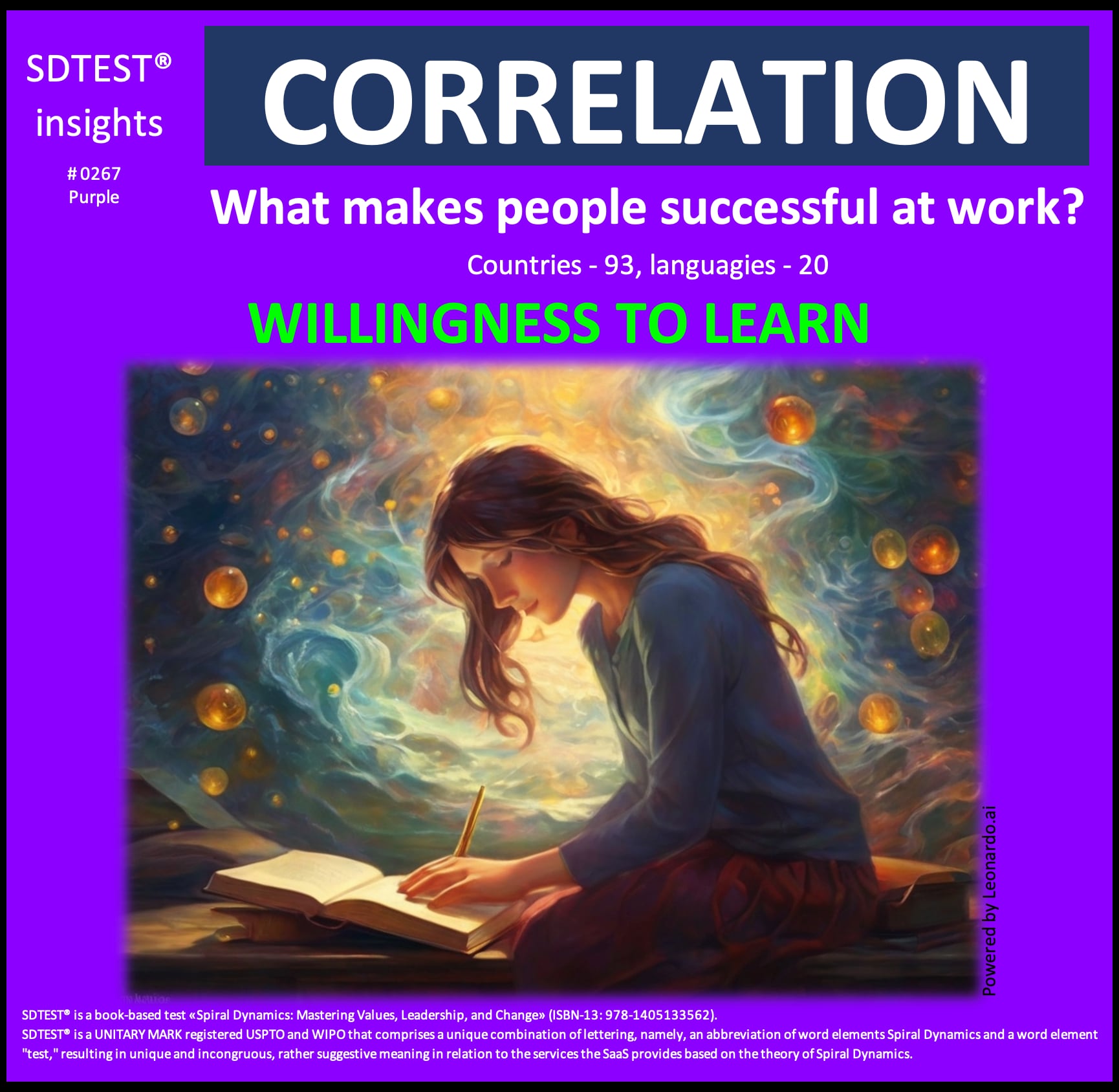
This positive correlation of 0.0419 between Willingness to learn and the Purple stage offers intriguing insights when viewed through the lens of the Purple value system:
Organizational Perspective:
Organizations operating within the Purple mindset might interpret this correlation as:
1. Validation of their emphasis on preserving and passing down traditional knowledge and practices.
2. An opportunity to reinforce the importance of learning from elders and spiritual leaders.
3. Confirmation that willingness to learn aligns with their respect for ancestral wisdom.
These organizations might respond by:
- Implementing mentorship programs that pair younger members with respected elders to pass down sacred knowledge.
- Developing rituals or ceremonies that celebrate and honor those who show dedication to learning traditional ways.
- Creating spaces for storytelling and oral traditions to transmit important organizational knowledge.
Team Perspective:
Teams operating from a Purple mindset might approach this correlation by:
1. Viewing it as a sign to strengthen bonds through shared learning experiences.
2. Interpreting it as a call to deepen their collective understanding of team traditions and rituals.
3. Seeing it as an opportunity to reinforce the team's connection to its spiritual or ancestral roots.
These teams might respond by:
- Instituting regular gatherings where team members share stories and lessons learned from their work experiences.
- Encouraging team members to learn and perform specific roles in team rituals or ceremonies.
- Developing a team "book of wisdom" that captures and preserves important learnings and traditions.
Individual Perspective:
Individuals aligned with the Purple value system might interpret this correlation as:
1. Personal validation of their respect for and willingness to learn from community elders and traditions.
2. An opportunity to strengthen their connection to the group by eagerly absorbing its customs and knowledge.
3. Inspiration to become a keeper and transmitter of essential communal wisdom.
These individuals might respond by:
- Seeking opportunities to learn from respected elders or spiritual leaders within the organization.
- Dedicating themselves to mastering traditional practices or skills valued by their community.
- Offering to assist in rituals or ceremonies to learn and preserve essential traditions.
This correlation, viewed through the Purple lens, suggests that those operating at the Purple level may associate willingness to learn with success at work because it aligns with their deep respect for tradition and communal knowledge. It implies that the Purple value system's reverence for ancestral wisdom and strong group identity harmonize with a positive attitude toward learning.
Ultimately, this correlation speaks to the enduring value of willingness to learn, even in value systems prioritizing tradition over innovation. It reminds us that in the Purple worldview, learning is not just about acquiring new skills but about deepening one's connection to the community, its history, and its spiritual beliefs. Success at work, in this context, may be closely tied to one's ability to absorb, embody, and eventually pass on the collective wisdom of the group.
In our analysis of the poll "Ageism in Career," we found an intriguing positive correlation that warrants closer examination:
0.1568 between the Age group 18-24 and the Red stage.
The critical value of the correlation coefficient for a normal distribution, by William Sealy Gosset (Student) r = 0.0804. This positive correlation of 0.1568 meets the reliability criteria but does not necessarily imply causation.
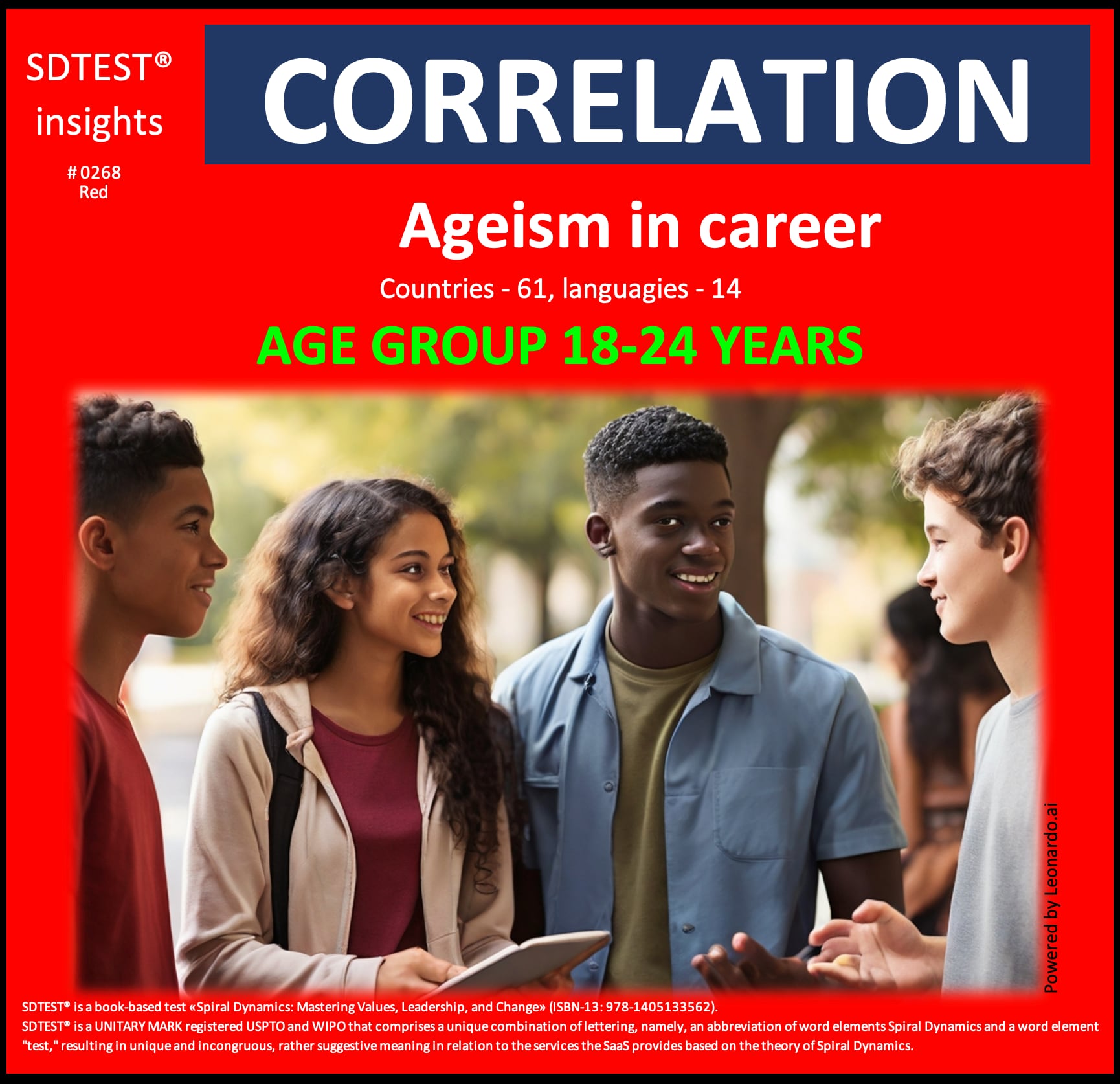
This positive correlation of 0.1568 between Ages 18-24 and the Red stage in the context of Ageism in Career offers intriguing insights when viewed through the lens of the Red value system:
Organizational Perspective:
Organizations operating within the Red mindset might interpret this correlation as:
1. Validation of their preference for young, aggressive talent to maintain dominance in the market.
2. An opportunity to exploit the ambition and energy of young workers for immediate gains.
3. Justification for dismissing older workers as less valuable or adaptable.
These organizations might respond by:
- Implementing aggressive recruitment strategies targeting young talent, emphasizing power and rapid advancement.
- Creating a highly competitive internal environment that favors youthful energy and risk-taking.
- Publicly celebrating young achievers to reinforce the narrative of youth as a key to success.
Team Perspective:
Teams operating from a Red mindset might approach this correlation by:
1. Viewing it as confirmation of their superiority over older colleagues or competing teams.
2. Interpreting it as a license to push for more organizational power and resources.
3. Seeing it as an opportunity to challenge established hierarchies and norms.
These teams might respond by:
- Fostering an intensely competitive atmosphere that rewards bold, impulsive actions.
- Marginalizing or excluding older team members perceived as less aggressive or adaptable.
- Lobbying aggressively for high-profile projects and resources, emphasizing their youthful energy as a key asset.
Individual Perspective:
Individuals aged 18-24 aligned with the Red value system might interpret this correlation as:
1. Personal validation of their right to dominate and succeed quickly in their careers.
2. An opportunity to assert themselves aggressively against older colleagues.
3. Justification for demanding rapid advancement and recognition, regardless of experience.
These individuals might respond by:
- Seeking high-visibility roles and challenging authority figures to prove their worth.
- Dismissing advice or mentorship from older colleagues as irrelevant or outdated.
- Engaging in risky or aggressive behavior to stand out and gain power quickly.
This correlation, viewed through the Red lens, suggests that young individuals operating at the Red level may be more likely to perceive and react strongly to ageism in their careers. It implies that the Red value system's impulsiveness, self-centeredness, and desire for immediate gratification align with a heightened awareness of age-related barriers to their rapid advancement.
From this perspective, the correlation invites us to explore the complex dynamics between youthful ambition and established power structures in the workplace. It prompts us to ask: How does the Red focus on immediate power and dominance influence perceptions of ageism among young professionals? What are the potential consequences of a Red-driven approach to career advancement regarding intergenerational workplace dynamics?
This interpretation doesn't necessarily imply that ageism is more prevalent among young professionals or in Red-oriented environments. Instead, it suggests that the Red value system's characteristics may lead to a more aggressive and self-centered approach to navigating age-related career challenges. The challenge lies in constructively channeling this youthful energy and ambition while fostering a more balanced and inclusive work environment across all age groups.
Ultimately, this correlation speaks to the volatile intersection of youthful ambition and career structures. It reminds us that in the Red worldview, the perception of ageism might be intensified by a desire for rapid advancement and a rejection of traditional hierarchies based on experience or tenure.
In our analysis of the poll "Reasons why people give up" (by Anna Vital [1]), we found an intriguing positive correlation that warrants closer examination:
0.3371 between the Fear failure more than desire success (Germany, two languages) and the Blue stage.
The critical value of the correlation coefficient for a normal distribution, by William Sealy Gosset (Student) r = 0.3336. This positive correlation of 0.3371 meets the reliability criteria but does not necessarily imply causation.

This positive correlation of 0.3371 between "Fear failure more than desire success" in Germany and the Blue stage offers intriguing insights when viewed through the lens of the Blue value system:
Organizational Perspective:
Organizations operating within the Blue mindset might interpret this correlation as:
1. Validation of their emphasis on strict procedures and risk aversion to maintain order and stability.
2. Confirmation that adherence to established norms is crucial for organizational success and individual security.
3. Justification for implementing rigorous quality control measures to prevent failures.
These organizations might respond by:
- Reinforcing clear hierarchies and chains of command to ensure accountability and minimize errors.
- Developing comprehensive rulebooks and standard operating procedures to guide all aspects of work.
- Implement strict performance evaluation systems that penalize mistakes or deviations from established protocols.
Team Perspective:
Teams operating from a Blue mindset might approach this correlation by:
1. Viewing it as a call to strengthen team discipline and adherence to established processes.
2. Interpreting it as a need for more precise guidelines and expectations to prevent team failures.
3. Seeing it as an opportunity to reinforce the importance of loyalty to team principles and objectives.
These teams might respond by:
- Instituting regular team meetings to review and reinforce proper procedures and protocols.
- Implementing a system of checks and balances within the team to catch and correct potential errors early.
- Emphasizing team unity and collective responsibility in following rules to avoid failures.
Individual Perspective:
Individuals aligned with the Blue value system might interpret this correlation as:
1. Personal validation of their cautious approach and strict adherence to rules.
2. An opportunity to demonstrate their loyalty and reliability by meticulously following established procedures.
3. Confirmation that maintaining the status quo is safer than risking failure through innovation or change.
These individuals might respond by:
- Seeking additional training or certifications to ensure they are fully compliant with all job requirements.
- Carefully documenting their work processes to demonstrate adherence to organizational standards.
- Avoid taking the initiative or suggesting changes that might lead to potential failures.
This correlation, viewed through the Blue lens, suggests that individuals and organizations operating at the Blue level in Germany may be more inclined to prioritize avoiding failure over pursuing success due to their strong emphasis on order, rules, and tradition. It implies that the Blue value system's characteristics of conformity, duty, and respect for authority align with a heightened fear of failure and deviation from established norms.
From this perspective, the correlation invites us to explore the interplay between cultural values, organizational structures, and individual motivations in the German context. It prompts us to ask: How does the Blue focus on order and tradition influence risk perception and decision-making in German organizations? What are the long-term consequences of prioritizing failure avoidance over success-seeking regarding innovation and adaptability?
This interpretation doesn't necessarily imply that German organizations or individuals are inherently risk-averse or incapable of success. Instead, it suggests that their approach to success may focus more on perfecting existing systems and avoiding mistakes than taking risks for potential gains. The challenge lies in balancing this valuable emphasis on quality and reliability with the need for innovation and adaptability in a rapidly changing global economy.
Ultimately, this correlation speaks to the complex relationship between societal values and individual motivations. It reminds us that in the Blue worldview, particularly within the German cultural context, the desire to maintain order and adhere to established norms may outweigh the drive for individual achievement or innovation.
In our analysis of the poll "What makes a boss a great leader?" we found an intriguing positive correlation that warrants closer examination:
0.1386 between the Empowering their people and the Orange stage.
The critical value of the correlation coefficient for a normal distribution, by William Sealy Gosset (Student) r = 0.0426. This positive correlation of 0.1386 meets the reliability criteria but does not necessarily imply causation.
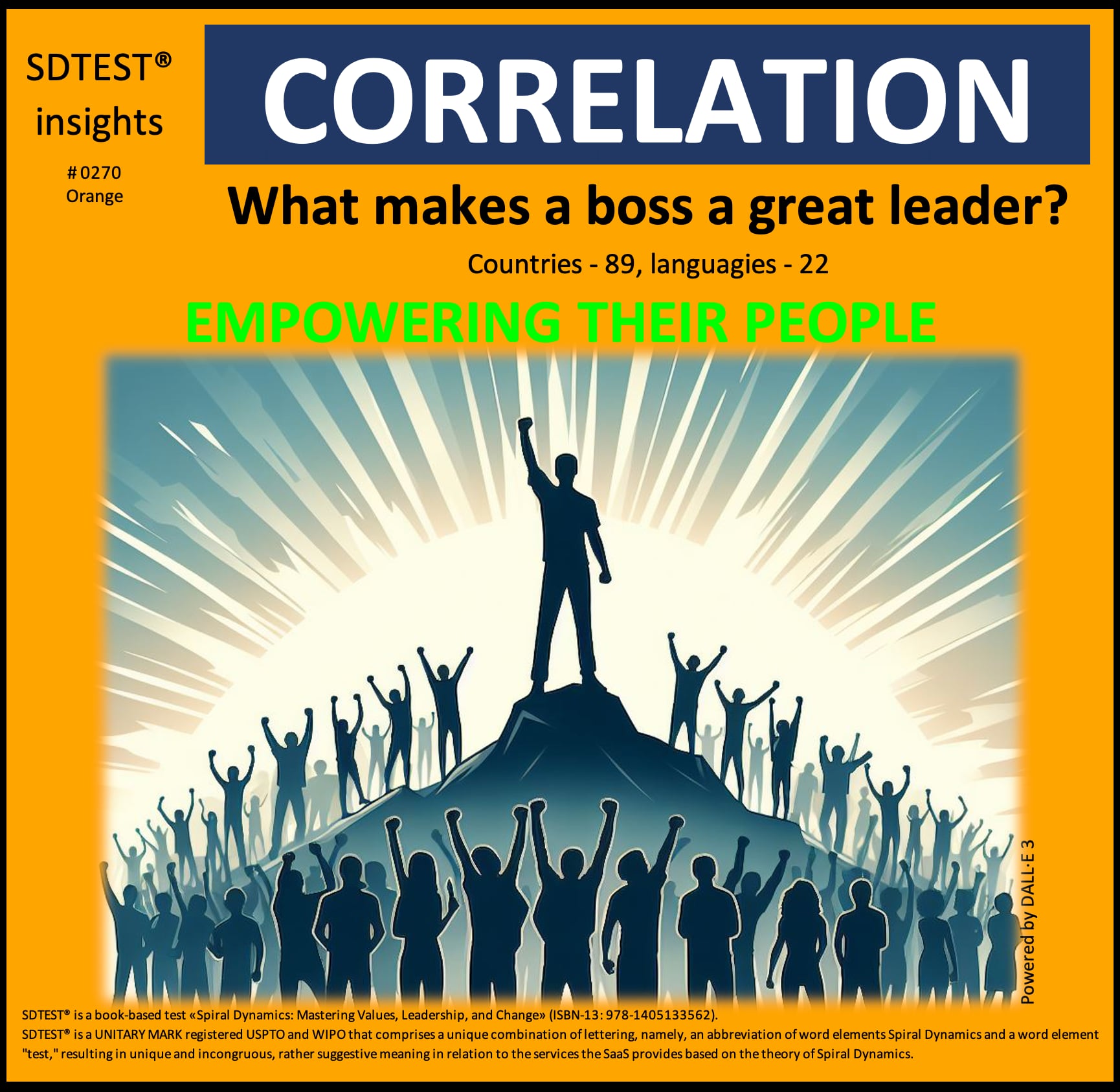
This positive correlation of 0.1386 between "Empowering Their People" and the Orange stage offers intriguing insights when viewed through the lens of the Orange value system:
Organizational Perspective:
Organizations operating within the Orange mindset might interpret this correlation as:
1. Validation of their focus on efficiency and results through empowered employees.
2. An opportunity to leverage individual talents for maximum organizational productivity.
3. Confirmation that empowerment leads to innovation and competitive advantage.
These organizations might respond by:
- Implementing data-driven performance management systems that reward individual initiative and results.
- Investing in cutting-edge training programs to enhance employee skills and decision-making capabilities.
- Developing clear, measurable objectives for employees, allowing them autonomy in achieving these goals.
Team Perspective:
Teams operating from an Orange mindset might approach this correlation by:
1. Viewing it as a call to optimize team performance through individual empowerment.
2. Interpreting it as a need for more apparent individual roles and responsibilities within the team.
3. Seeing it as an opportunity to foster healthy competition and innovation among team members.
These teams might respond by:
- Implementing project management tools that allow for individual tracking of contributions and results.
- Encouraging team members to take ownership of specific project components or client relationships.
- Instituting regular "innovation challenges" where empowered individuals can pitch new ideas to improve team performance.
Individual Perspective:
Individuals aligned with the Orange value system might interpret this correlation as:
1. Personal validation of their desire for autonomy and self-directed achievement.
2. An opportunity to demonstrate their unique value and capabilities within the organization.
3. Confirmation that taking initiative and driving results is vital to career advancement.
These individuals might respond by:
- Actively seeking out opportunities to lead high-visibility projects or initiatives.
- Investing in personal development and acquiring new skills to enhance their value.
- Setting ambitious personal performance targets and developing strategies to exceed them.
This correlation, viewed through the Orange lens, suggests that empowering people aligns well with the Orange value system's emphasis on individual achievement, rational problem-solving, and results-oriented thinking. It implies that the Orange characteristics of ambition, competitiveness, and focus on efficiency harmonize with a leadership style that empowers individuals to take initiative and drive outcomes.
From this perspective, the correlation invites us to explore the relationship between employee empowerment and organizational success in achievement-oriented cultures. It prompts us to ask how empowering individuals contributes to organizational efficiency and innovation and what balance of structure and autonomy optimizes performance in Orange-oriented environments.
This interpretation doesn't suggest that Orange-oriented organizations or individuals view empowerment as an end in itself. Instead, it indicates that they see empowerment as a strategic tool for achieving concrete objectives and measurable success. The challenge lies in creating systems that empower individuals while maintaining the focus on collective goals and organizational success characteristic of the Orange value system.
Ultimately, this correlation speaks to the synergy between individual empowerment and the goal-oriented nature of the Orange value system. It reminds us that in the Orange worldview, empowering people fosters a positive work environment and unleashes individual potential to drive tangible results and competitive advantage.
In our analysis of the poll "Ageism’s causes," we found an intriguing positive correlation that warrants closer examination:
0.0915 between the No, ageism is not the result only of interpersonal interactions and the Green stage.
The critical value of the correlation coefficient for a normal distribution, by William Sealy Gosset (Student) r = 0.0865. This positive correlation of 0.0915 meets the reliability criteria but does not necessarily imply causation.
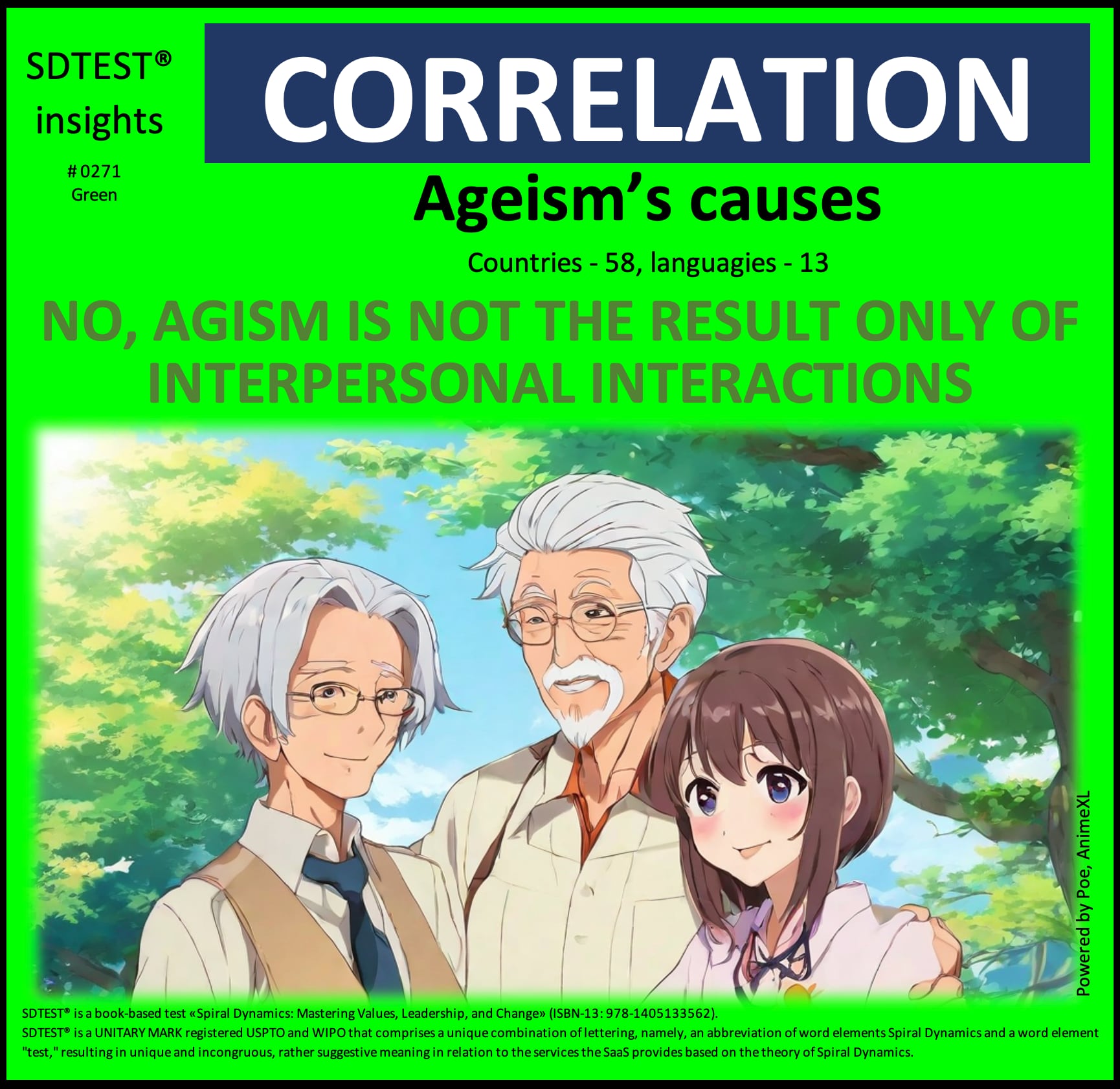
This positive correlation of 0.0915 between recognizing that ageism is not solely the result of interpersonal interactions and the Green stage offers intriguing insights when viewed through the lens of the Green value system:
Organizational Perspective:
Organizations operating within the Green mindset might interpret this correlation as:
1. Validation of their holistic approach to understanding and addressing societal issues like ageism.
2. An opportunity to examine and transform systemic structures that perpetuate age-based discrimination.
3. Confirmation that addressing ageism requires a multifaceted, inclusive strategy beyond individual interactions.
These organizations might respond by:
- Conducting comprehensive audits of their policies, practices, and culture to identify systemic ageism.
- Implementing intergenerational mentoring programs that foster mutual understanding and respect.
- Developing partnerships with diverse community organizations to address ageism at a broader societal level.
Team Perspective:
Teams operating from a Green mindset might approach this correlation by:
1. Viewing it as a call to examine how team dynamics and structures might unconsciously perpetuate ageist attitudes.
2. Interpreting it as a need for more inclusive decision-making processes that value diverse life experiences.
3. Seeing it as an opportunity to foster a team culture that celebrates the unique contributions of all age groups.
These teams might respond by:
- Facilitating open dialogues about age-related biases and their systemic roots within the team and the broader organization.
- Implementing collaborative projects that intentionally leverage the diverse perspectives of different generations.
- Developing team rituals that honor all team members' collective wisdom and experiences, regardless of age.
Individual Perspective:
Individuals aligned with the Green value system might interpret this correlation as:
1. Personal validation of their systemic approach to social issues like ageism.
2. An opportunity to reflect on how broader societal ageist structures might influence their actions and beliefs.
3. Inspiration to become advocates for age inclusivity beyond just their interactions.
These individuals might respond by:
- Educating themselves about the historical, cultural, and economic factors contributing to ageism.
- Initiating conversations within their networks about the systemic nature of ageism and ways to address it.
- Actively seeking out intergenerational relationships and experiences to broaden their perspective and challenge societal norms.
This correlation, viewed through the Green lens, suggests that those operating at the Green level have a more nuanced understanding of ageism as a complex, systemic issue rather than a matter of individual prejudices. It implies that the Green value system's characteristics of holistic thinking, concern for all, and focus on sustainability align with a more comprehensive view of social challenges like ageism.
From this perspective, the correlation invites us to explore the multifaceted nature of ageism and its roots in societal structures, cultural narratives, and economic systems. It prompts us to ask How our institutions, media representations, and financial policies contribute to ageist attitudes. What systemic changes are necessary to create a genuinely age-inclusive society?
This interpretation doesn't suggest that interpersonal interactions are unimportant in addressing ageism. Instead, it recognizes that these interactions are part of a larger systemic context that needs to be understood and addressed. The challenge lies in developing comprehensive strategies to tackle ageism at both the interpersonal and systemic levels, fostering a society that genuinely values and includes people of all ages.
Ultimately, this correlation speaks to the evolving understanding of social issues as we move towards more advanced value systems. It reminds us that in the Green worldview, addressing ageism requires looking beyond individual behaviors to examine and transform the broader systems and structures that shape our society.
In our analysis of the poll "Trust" (by WVS), we found an intriguing positive correlation that warrants closer examination:
0.0731 between the Politicians are often incompetent and ineffective / Agree and the Yellow stage.
The critical value of the correlation coefficient for a normal distribution, by William Sealy Gosset (Student) r = 0.064. This positive correlation of 0.0731 meets the reliability criteria but does not necessarily imply causation.
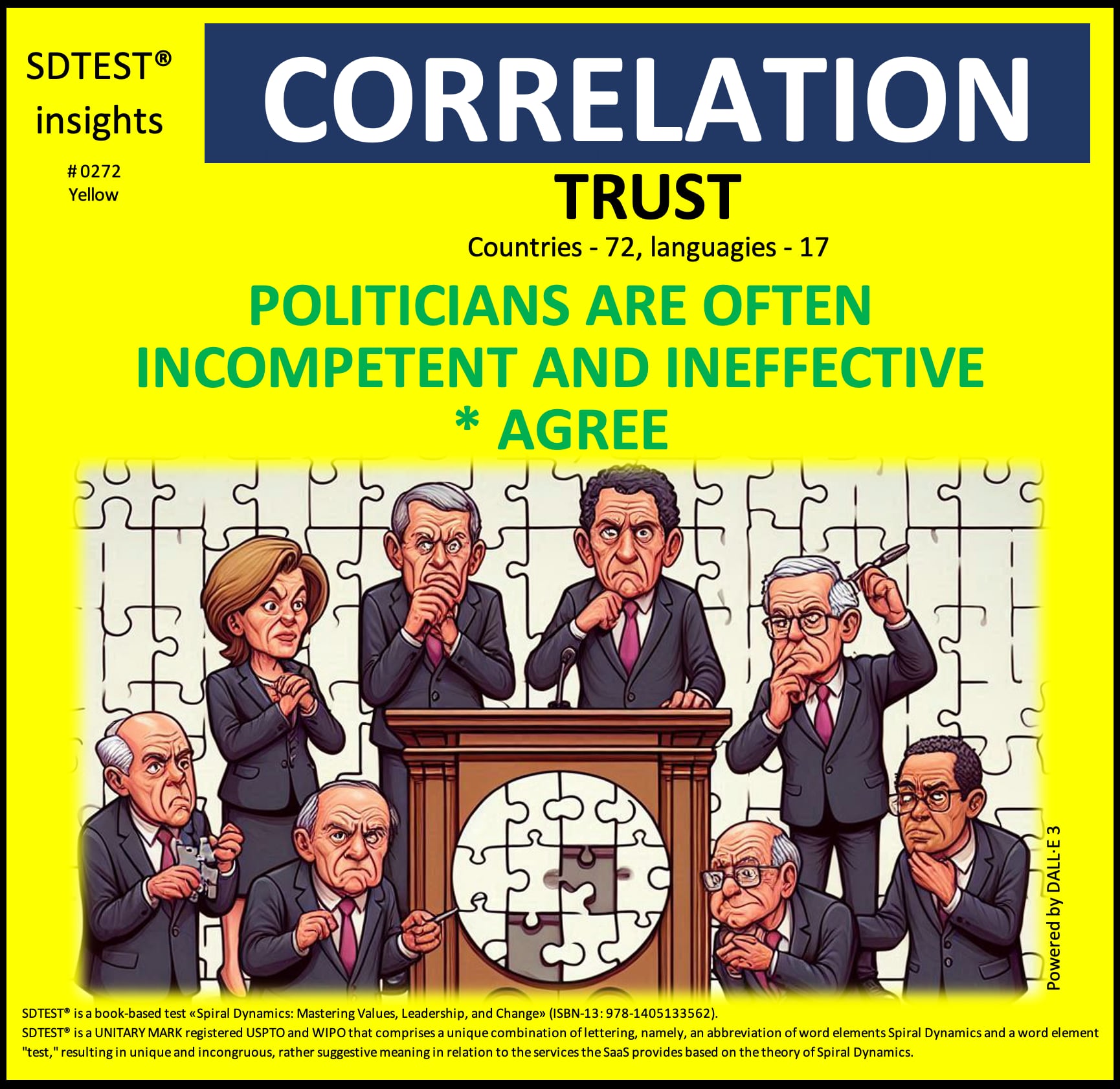
This positive correlation of 0.0731 between agreeing that "Politicians are often incompetent and ineffective" and the Yellow stage offers intriguing insights when viewed through the lens of the Yellow value system:
Organizational Perspective:
Companies operating within the Yellow mindset might interpret this correlation as:
1. Validation of their complex systems understanding, recognizing the limitations of traditional political structures.
2. An opportunity to transcend conventional governance models and explore more adaptive, integrative approaches.
3. Confirmation that effective leadership requires a more nuanced, multifaceted skill set than traditional politics often cultivates.
These organizations might respond by:
- Implementing holistic decision-making processes that consider multiple perspectives and long-term systemic impacts.
- Developing leadership programs that foster adaptability, systems thinking, and the ability to navigate complexity.
- Exploring innovative governance structures that distribute power and responsibility more dynamically.
Team Perspective:
Teams operating from a Yellow mindset might approach this correlation by:
1. Viewing it as an invitation to reimagine how collective decision-making and leadership can function more effectively.
2. Interpreting it as a call to develop more sophisticated problem-solving approaches that transcend traditional political limitations.
3. Seeing it as an opportunity to integrate diverse viewpoints and skills in ways that traditional political systems often fail to do.
These teams might respond by:
- Implementing flexible, self-organizing structures that allow for rapid adaptation to complex challenges.
- Fostering a culture of continuous learning and personal growth to enhance collective problem-solving capabilities.
- Developing decision-making processes that explicitly consider multiple perspectives and potential long-term consequences.
Individual Perspective:
Individuals aligned with the Yellow value system might interpret this correlation as:
1. Personal validation of their ability to see beyond conventional political narratives and understand systemic complexities.
2. An opportunity to engage with governance and social issues more innovatively and integratively.
3. Inspiration to develop leadership skills that transcend traditional political competencies.
These individuals might respond by:
- Seeking opportunities to influence systemic change through non-traditional channels or grassroots movements.
- Developing their capacity for systems thinking and integrative problem-solving to address complex societal challenges.
- Engaging in civic participation in ways that bring multiple perspectives together and foster more holistic solutions.
This correlation, viewed through the Yellow lens, suggests that those operating at the Yellow level may perceive the limitations of traditional political systems more acutely due to their advanced cognitive frameworks and understanding of complex systems. It implies that the Yellow value system's characteristics of integrative thinking, personal growth focus, and ability to see multiple perspectives align with a more critical view of conventional political effectiveness.
This interpretation doesn't necessarily imply that Yellow-oriented individuals or organizations are cynical about governance. Instead, it suggests they may be more aware of the gap between the complexities of modern challenges and the capabilities of traditional political systems. The opportunity lies in leveraging this awareness to develop more sophisticated, integrative approaches to collective decision-making and societal progress.
Ultimately, this correlation speaks to the evolving nature of governance and leadership as human consciousness develops. It reminds us that in the Yellow worldview, effective leadership and political systems must integrate multiple perspectives, adapt to complex challenges, and foster ongoing personal and collective growth.
In our analysis of the poll "Oxford Happiness Survey," we found an intriguing positive correlation that warrants closer examination:
0.1484 between the I find beauty in some things / Strongly Agree and the Turquoise stage.
The critical value of the correlation coefficient for a normal distribution, by William Sealy Gosset (Student) r = 0.0547. This positive correlation of 0.1484 meets the reliability criteria but does not necessarily imply causation.

This positive correlation of 0.1484 between strongly agreeing with "I find beauty in some things," and the Turquoise stage offers intriguing insights when viewed through the lens of the Turquoise value system:
Organizational Perspective:
Companies operating within the Turquoise mindset might interpret this correlation as:
1. Validation of their holistic approach to business that recognizes beauty in the interconnectedness of all systems.
2. An opportunity to cultivate a deeper appreciation for their work's aesthetic and spiritual dimensions and impact.
3. Confirmation that recognizing beauty is integral to fostering a harmonious relationship with the broader ecosystem.
These organizations might respond by:
- Integrating aesthetic and natural elements into workplace design to nurture a sense of beauty and connection with nature.
- Developing decision-making processes that consider the beauty and harmony of outcomes across multiple dimensions (social, environmental, economic).
- Implement practices that encourage employees to pause and regularly appreciate the beauty of their work and surroundings.
Team Perspective:
Teams operating from a Turquoise mindset might approach this correlation by:
1. Viewing it as an invitation to cultivate a collective appreciation for the beauty inherent in their collaborative efforts and outcomes.
2. Interpreting it as a call to integrate aesthetic considerations into their problem-solving and innovation processes.
3. Seeing it as an opportunity to deepen their connection to each other and their work through shared experiences of beauty.
These teams might respond by:
- Incorporating moments of reflection or meditation in team meetings to attune to the beauty of their collective purpose and impact.
- Engaging in creative exercises encouraging team members to express and share their perceptions of beauty in their work and the world.
- Developing projects that explicitly aim to bring more beauty into the world, whether through design, environmental restoration, or social harmony.
Individual Perspective:
Individuals aligned with the Turquoise value system might interpret this correlation as:
1. Personal validation of their capacity to perceive and appreciate the intrinsic beauty in the interconnected web of existence.
2. An opportunity to deepen their spiritual connection to the world through a more refined appreciation of beauty.
3. Inspiration to cultivate and share their sense of beauty as a means of fostering greater harmony and awareness in others.
These individuals might respond by:
- Developing daily practices to attune themselves to the beauty in their surroundings, from natural landscapes to human interactions.
- Seeking diverse experiences and perspectives to expand their understanding and appreciation of beauty across cultures and ecosystems.
- Integrating their sense of beauty into their work and relationships to inspire a more holistic, interconnected worldview in others.
This correlation, viewed through the Turquoise lens, suggests that those operating at the Turquoise level have a heightened capacity to perceive and appreciate beauty as an integral aspect of existence. It implies that the Turquoise value system's characteristics of holistic thinking, ecological awareness, and spiritual connection align with a more profound and pervasive experience of beauty in the world.
From this perspective, the correlation invites us to explore the role of beauty in fostering a more integrated, sustainable, and harmonious world. It prompts us to ask How a deeper appreciation of beauty might inform our approach to global challenges. How can recognizing beauty serve as a bridge between diverse perspectives and foster a more inclusive, interconnected society?
This interpretation doesn't suggest that Turquoise-oriented individuals or organizations focus solely on surface-level aesthetics. Rather, it indicates a deep, holistic appreciation for the beauty inherent in the complex web of life and human experience. The opportunity lies in leveraging this expanded sense of beauty to inspire more harmonious, sustainable, and compassionate ways of living and working.
Ultimately, this correlation speaks to the evolving nature of human consciousness and our relationship with the world around us. It reminds us that in the Turquoise worldview, the appreciation of beauty is not merely an aesthetic preference but a fundamental way of perceiving and engaging with the interconnected nature of reality.
What insights do you gain from today's correlation? How might we study this relationship more carefully before deducing causation?
We welcome respectful and wise perspectives! Stay tuned every week as we share more results and insights.
After login or registration, free access to the poll results in the FAQ section.
[1] https://www.linkedin.com/in/annavital
2024.09.29
FearpersonqualitiesprojectorganizationalstructureRACIresponsibilitymatrixCritical ChainProject Managementfocus factorJiraempathyleadersbossGermanyChinaPolicyUkraineRussiawarvolatilityuncertaintycomplexityambiguityVUCArelocatejobproblemcountryreasongive upobjectivekeyresultmathematicalpsychologyMBTIHR metricsstandardDEIcorrelationriskscoringmodelGame TheoryPrisoner's Dilemma
ويلري ڪوکوڪو
پيداوار جو مالڪ SaaS SDTEST®
والري 1993 ۾ هڪ سماجي تدريسي-ماهر نفسيات جي حيثيت سان قابليت حاصل ڪئي هئي ۽ ان کان پوء هن پنهنجي علم کي پروجيڪٽ مينيجمينٽ ۾ لاڳو ڪيو آهي.
والريئي 2013 ۾ ماسٽر جي ڊگري حاصل ڪئي ۽ پروجيڪٽ ۽ پروگرام مئنيجر جي قابليت حاصل ڪئي. پنهنجي ماسٽر پروگرام دوران، هو پروجيڪٽ روڊ ميپ (GPM Deutsche Gesellschaft für Projektmanagement e. V.) ۽ اسپيرل ڊائنامڪس کان واقف ٿيو.
والري V.U.C.A جي غير يقيني صورتحال کي ڳولڻ جو ليکڪ آهي. تصور استعمال ڪندي سرپل ڊائنامڪس ۽ رياضياتي انگ اکر نفسيات ۾، ۽ 38 بين الاقوامي پول.

